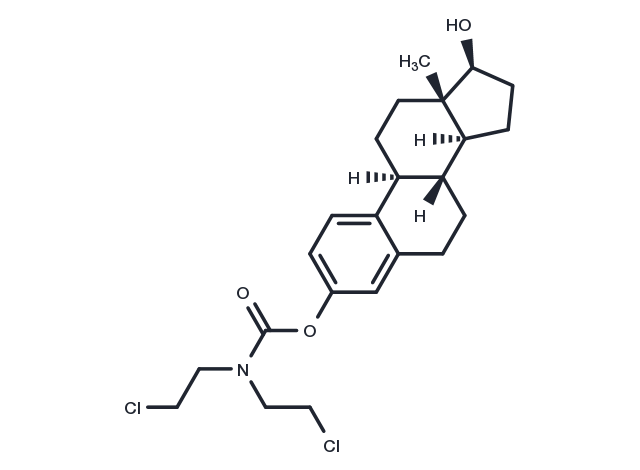Powder: -20°C for 3 years | In solvent: -80°C for 1 year


Estramustine (LEO-275) is a nitrogen mustard linked to estradiol, usually as phosphate. Estramustine has been used to treat prostatic neoplasms; also has radiation protective properties. Estramustine is selectively taken up by prostate cells and exerts antineoplastic effects by interfering with microtubule of dynamics and by reducing plasma levels of testosterone.

| Pack Size | Availability | Price/USD | Quantity |
|---|---|---|---|
| 5 mg | In stock | $ 39.00 | |
| 10 mg | In stock | $ 64.00 | |
| 25 mg | In stock | $ 128.00 | |
| 50 mg | In stock | $ 213.00 | |
| 100 mg | In stock | $ 347.00 | |
| 500 mg | In stock | $ 825.00 | |
| 1 mL * 10 mM (in DMSO) | In stock | $ 52.00 |

| Description | Estramustine (LEO-275) is a nitrogen mustard linked to estradiol, usually as phosphate. Estramustine has been used to treat prostatic neoplasms; also has radiation protective properties. Estramustine is selectively taken up by prostate cells and exerts antineoplastic effects by interfering with microtubule of dynamics and by reducing plasma levels of testosterone. |
| Synonyms | NSC-89201, NSC 89201, LEO 275, LEO275, NSC89201, LEO-275 |
| Molecular Weight | 440.4 |
| Formula | C23H31Cl2NO3 |
| CAS No. | 2998-57-4 |
Powder: -20°C for 3 years | In solvent: -80°C for 1 year
DMSO: 55 mg/ml (124.89 mM)
You can also refer to dose conversion for different animals. More
bottom
Please see Inhibitor Handling Instructions for more frequently ask questions. Topics include: how to prepare stock solutions, how to store products, and cautions on cell-based assays & animal experiments, etc.
Estramustine 2998-57-4 Cytoskeletal Signaling Microtubule Associated Microtubule/Tubulin NSC-89201 NSC 89201 inhibit prostate tumor LEO 275 Inhibitor LEO275 NSC89201 antineoplastic LEO-275 depolymerization antimitotic inhibitor
